International Relation and Global Economy
VerifiedAdded on 2023/06/16
|11
|2665
|145
AI Summary
This article explores the policies leading to success of East Asian economies and the growth in these economies. It discusses the public policies of eight high performing economies and how they helped in improving human welfare, economic growth and equitable distribution of income. The success of Asia economies can be attributed to number of factors such as export growth, building institutional basis for growth, accumulating physical and human capital, and productivity change and efficient allocation. The careful interventions of policies have benefitted in terms of rapid growth experienced by Japan and most of East Asian economies.
Contribute Materials
Your contribution can guide someone’s learning journey. Share your
documents today.
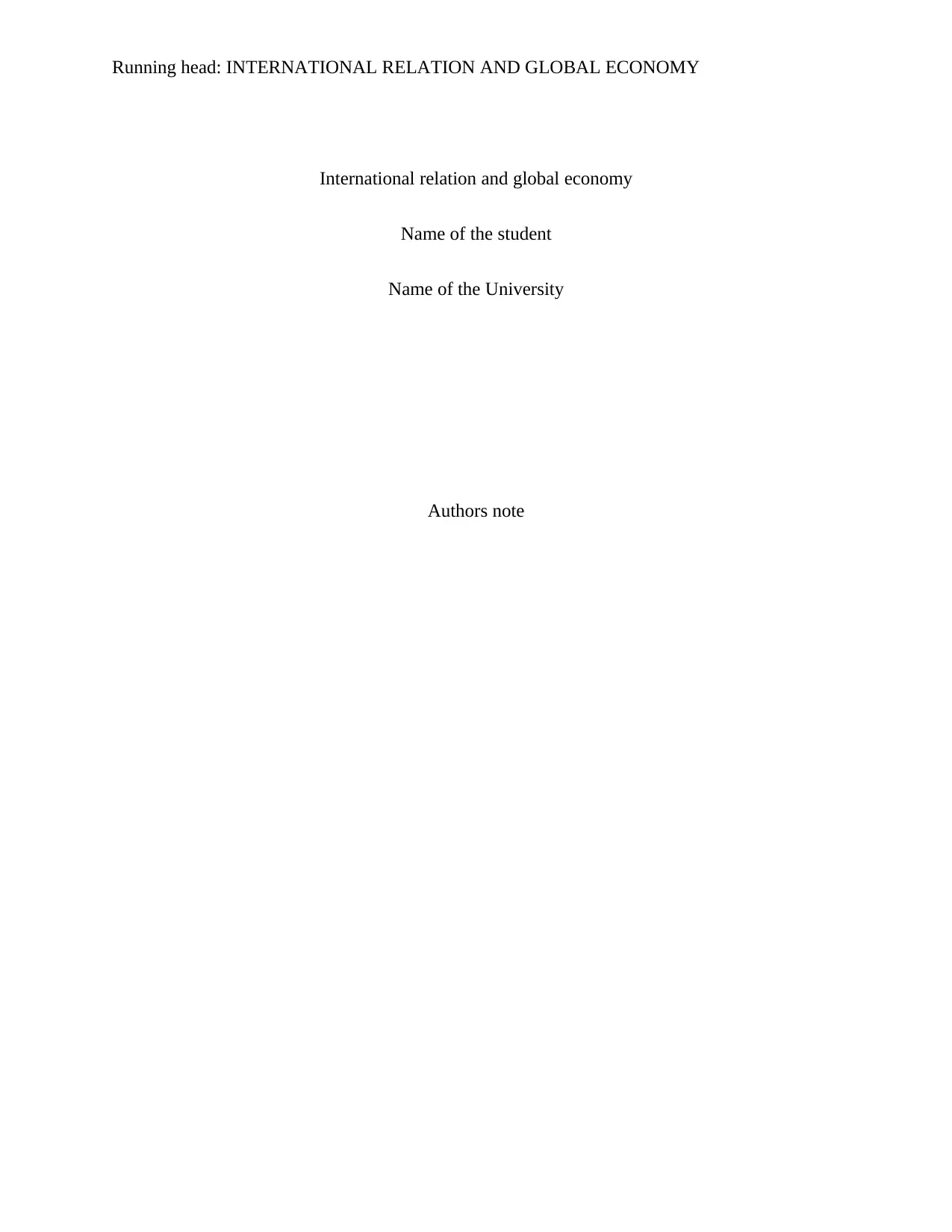
Running head: INTERNATIONAL RELATION AND GLOBAL ECONOMY
International relation and global economy
Name of the student
Name of the University
Authors note
International relation and global economy
Name of the student
Name of the University
Authors note
Secure Best Marks with AI Grader
Need help grading? Try our AI Grader for instant feedback on your assignments.

1
INTERNATIONAL RELATION AND GLOBAL ECONOMY
Introduction:
A remarkable record of sustained and high economic growth was witnessed in East Asian
economies and compared to all region of world, twenty East Asia’s economies, the growth rate
was faster. Getting basic rights was the main reason behind high growth achievement and the
principle engines of growth comprised of rapidly growing human capital and private domestic
investment. High level of investments in the economies was sustained by high level of domestic
financial savings. Compared to other developing world, East Asian economies witnessed
declining growth in population rate (Burchill et al. 2013). The major ingredient of rapid
economic growth was fundamentally sound development policy. Essential framework of private
investment was provided by unusually stable macro-economic performance and macroeconomic
management. World Bank in its report of East Asian miracle 1993, describes the policies
associated with rapid growth by expanding in neoclassical views. This has provided with
systematic clarification how carefully limited and effective government activism has helped
developing countries in experiencing rapid growth. It has been argued by neo classical adherents
that low relative price distortions was mainly because of absence of distortionary and price
control policies and orientation of these economies towards international trade (Baylis et al.
2017).
Discussion:
The public policies of eight high performing economies is examined in the World Bank
report for year 1965 to 1990. Report helps in uncovering the role of policies that helped in
improving human welfare, economic growth and equitable distribution of income in Japan, Hong
Kong, Malaysia, Indonesia, Singapore, Republic of Korea, Thailand and Taiwan. Sound policies
development helped in stabilization of high performing Asian economies that led to high growth.
INTERNATIONAL RELATION AND GLOBAL ECONOMY
Introduction:
A remarkable record of sustained and high economic growth was witnessed in East Asian
economies and compared to all region of world, twenty East Asia’s economies, the growth rate
was faster. Getting basic rights was the main reason behind high growth achievement and the
principle engines of growth comprised of rapidly growing human capital and private domestic
investment. High level of investments in the economies was sustained by high level of domestic
financial savings. Compared to other developing world, East Asian economies witnessed
declining growth in population rate (Burchill et al. 2013). The major ingredient of rapid
economic growth was fundamentally sound development policy. Essential framework of private
investment was provided by unusually stable macro-economic performance and macroeconomic
management. World Bank in its report of East Asian miracle 1993, describes the policies
associated with rapid growth by expanding in neoclassical views. This has provided with
systematic clarification how carefully limited and effective government activism has helped
developing countries in experiencing rapid growth. It has been argued by neo classical adherents
that low relative price distortions was mainly because of absence of distortionary and price
control policies and orientation of these economies towards international trade (Baylis et al.
2017).
Discussion:
The public policies of eight high performing economies is examined in the World Bank
report for year 1965 to 1990. Report helps in uncovering the role of policies that helped in
improving human welfare, economic growth and equitable distribution of income in Japan, Hong
Kong, Malaysia, Indonesia, Singapore, Republic of Korea, Thailand and Taiwan. Sound policies
development helped in stabilization of high performing Asian economies that led to high growth.
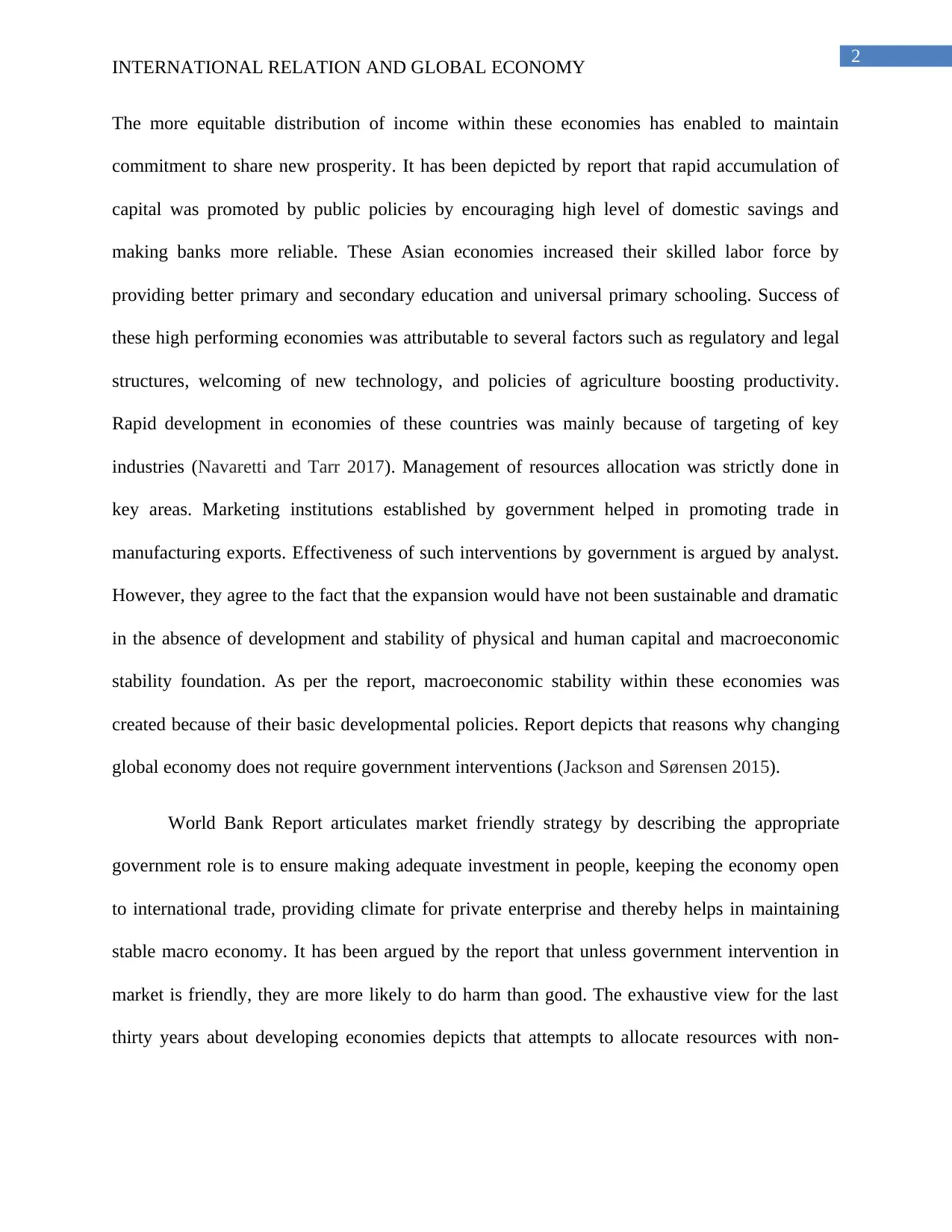
2
INTERNATIONAL RELATION AND GLOBAL ECONOMY
The more equitable distribution of income within these economies has enabled to maintain
commitment to share new prosperity. It has been depicted by report that rapid accumulation of
capital was promoted by public policies by encouraging high level of domestic savings and
making banks more reliable. These Asian economies increased their skilled labor force by
providing better primary and secondary education and universal primary schooling. Success of
these high performing economies was attributable to several factors such as regulatory and legal
structures, welcoming of new technology, and policies of agriculture boosting productivity.
Rapid development in economies of these countries was mainly because of targeting of key
industries (Navaretti and Tarr 2017). Management of resources allocation was strictly done in
key areas. Marketing institutions established by government helped in promoting trade in
manufacturing exports. Effectiveness of such interventions by government is argued by analyst.
However, they agree to the fact that the expansion would have not been sustainable and dramatic
in the absence of development and stability of physical and human capital and macroeconomic
stability foundation. As per the report, macroeconomic stability within these economies was
created because of their basic developmental policies. Report depicts that reasons why changing
global economy does not require government interventions (Jackson and Sørensen 2015).
World Bank Report articulates market friendly strategy by describing the appropriate
government role is to ensure making adequate investment in people, keeping the economy open
to international trade, providing climate for private enterprise and thereby helps in maintaining
stable macro economy. It has been argued by the report that unless government intervention in
market is friendly, they are more likely to do harm than good. The exhaustive view for the last
thirty years about developing economies depicts that attempts to allocate resources with non-
INTERNATIONAL RELATION AND GLOBAL ECONOMY
The more equitable distribution of income within these economies has enabled to maintain
commitment to share new prosperity. It has been depicted by report that rapid accumulation of
capital was promoted by public policies by encouraging high level of domestic savings and
making banks more reliable. These Asian economies increased their skilled labor force by
providing better primary and secondary education and universal primary schooling. Success of
these high performing economies was attributable to several factors such as regulatory and legal
structures, welcoming of new technology, and policies of agriculture boosting productivity.
Rapid development in economies of these countries was mainly because of targeting of key
industries (Navaretti and Tarr 2017). Management of resources allocation was strictly done in
key areas. Marketing institutions established by government helped in promoting trade in
manufacturing exports. Effectiveness of such interventions by government is argued by analyst.
However, they agree to the fact that the expansion would have not been sustainable and dramatic
in the absence of development and stability of physical and human capital and macroeconomic
stability foundation. As per the report, macroeconomic stability within these economies was
created because of their basic developmental policies. Report depicts that reasons why changing
global economy does not require government interventions (Jackson and Sørensen 2015).
World Bank Report articulates market friendly strategy by describing the appropriate
government role is to ensure making adequate investment in people, keeping the economy open
to international trade, providing climate for private enterprise and thereby helps in maintaining
stable macro economy. It has been argued by the report that unless government intervention in
market is friendly, they are more likely to do harm than good. The exhaustive view for the last
thirty years about developing economies depicts that attempts to allocate resources with non-
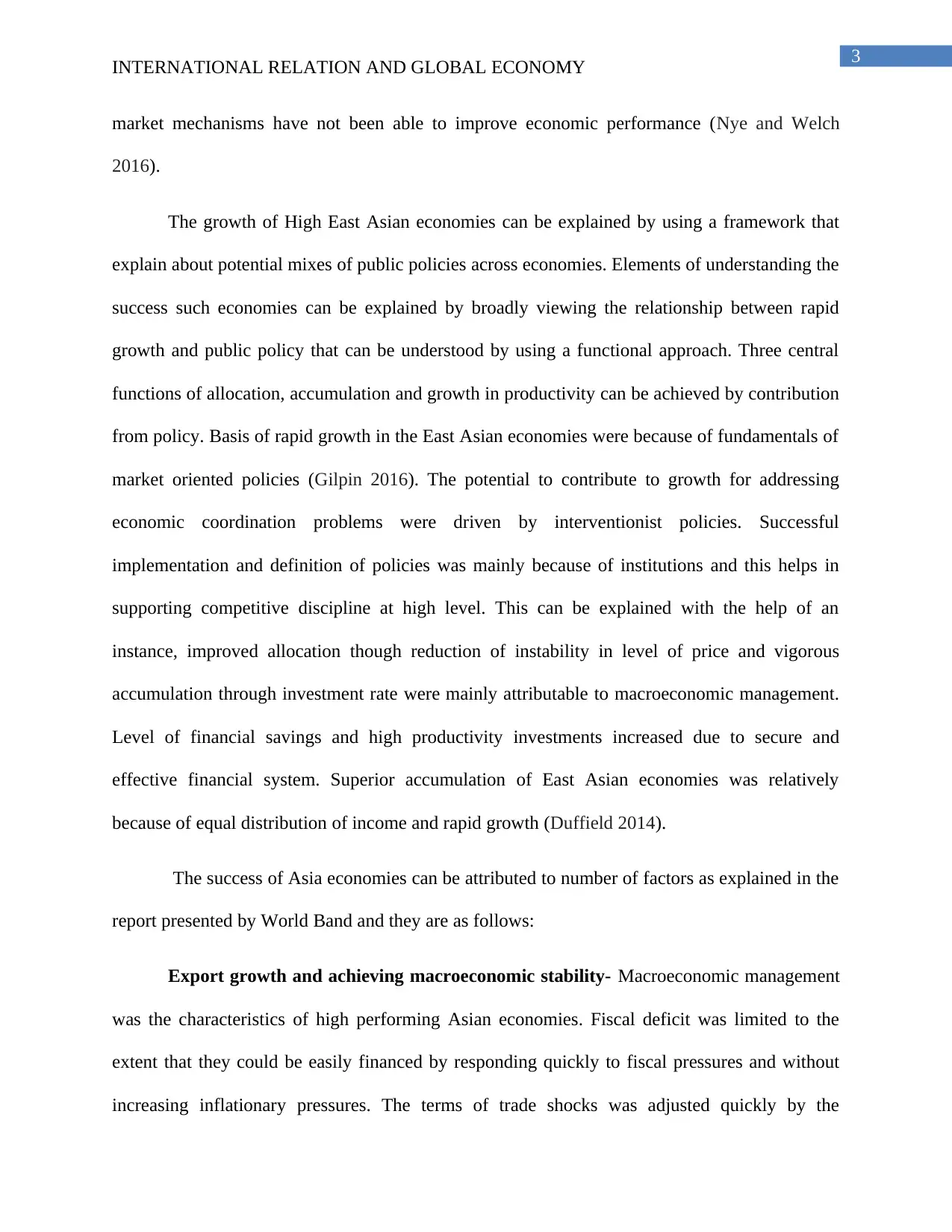
3
INTERNATIONAL RELATION AND GLOBAL ECONOMY
market mechanisms have not been able to improve economic performance (Nye and Welch
2016).
The growth of High East Asian economies can be explained by using a framework that
explain about potential mixes of public policies across economies. Elements of understanding the
success such economies can be explained by broadly viewing the relationship between rapid
growth and public policy that can be understood by using a functional approach. Three central
functions of allocation, accumulation and growth in productivity can be achieved by contribution
from policy. Basis of rapid growth in the East Asian economies were because of fundamentals of
market oriented policies (Gilpin 2016). The potential to contribute to growth for addressing
economic coordination problems were driven by interventionist policies. Successful
implementation and definition of policies was mainly because of institutions and this helps in
supporting competitive discipline at high level. This can be explained with the help of an
instance, improved allocation though reduction of instability in level of price and vigorous
accumulation through investment rate were mainly attributable to macroeconomic management.
Level of financial savings and high productivity investments increased due to secure and
effective financial system. Superior accumulation of East Asian economies was relatively
because of equal distribution of income and rapid growth (Duffield 2014).
The success of Asia economies can be attributed to number of factors as explained in the
report presented by World Band and they are as follows:
Export growth and achieving macroeconomic stability- Macroeconomic management
was the characteristics of high performing Asian economies. Fiscal deficit was limited to the
extent that they could be easily financed by responding quickly to fiscal pressures and without
increasing inflationary pressures. The terms of trade shocks was adjusted quickly by the
INTERNATIONAL RELATION AND GLOBAL ECONOMY
market mechanisms have not been able to improve economic performance (Nye and Welch
2016).
The growth of High East Asian economies can be explained by using a framework that
explain about potential mixes of public policies across economies. Elements of understanding the
success such economies can be explained by broadly viewing the relationship between rapid
growth and public policy that can be understood by using a functional approach. Three central
functions of allocation, accumulation and growth in productivity can be achieved by contribution
from policy. Basis of rapid growth in the East Asian economies were because of fundamentals of
market oriented policies (Gilpin 2016). The potential to contribute to growth for addressing
economic coordination problems were driven by interventionist policies. Successful
implementation and definition of policies was mainly because of institutions and this helps in
supporting competitive discipline at high level. This can be explained with the help of an
instance, improved allocation though reduction of instability in level of price and vigorous
accumulation through investment rate were mainly attributable to macroeconomic management.
Level of financial savings and high productivity investments increased due to secure and
effective financial system. Superior accumulation of East Asian economies was relatively
because of equal distribution of income and rapid growth (Duffield 2014).
The success of Asia economies can be attributed to number of factors as explained in the
report presented by World Band and they are as follows:
Export growth and achieving macroeconomic stability- Macroeconomic management
was the characteristics of high performing Asian economies. Fiscal deficit was limited to the
extent that they could be easily financed by responding quickly to fiscal pressures and without
increasing inflationary pressures. The terms of trade shocks was adjusted quickly by the
Secure Best Marks with AI Grader
Need help grading? Try our AI Grader for instant feedback on your assignments.
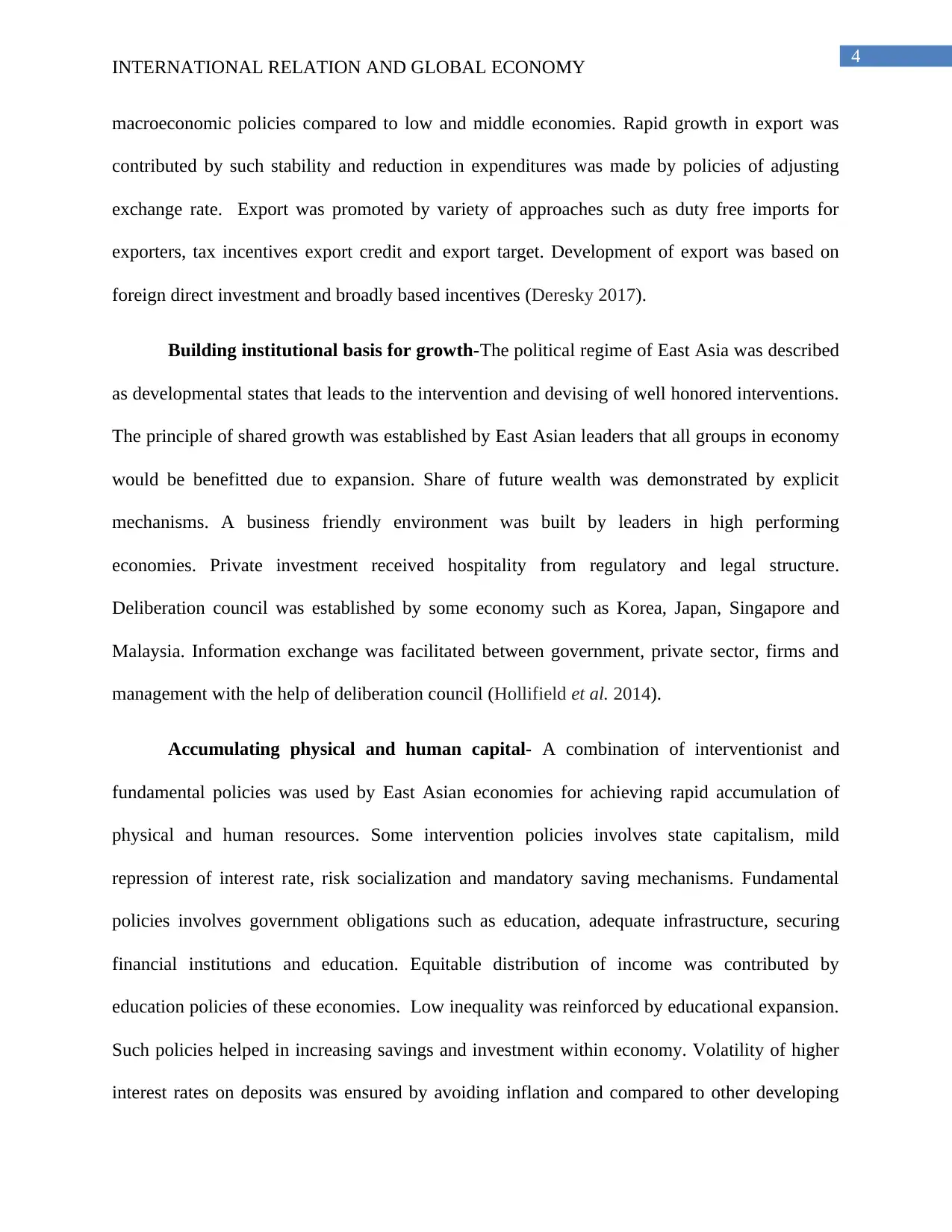
4
INTERNATIONAL RELATION AND GLOBAL ECONOMY
macroeconomic policies compared to low and middle economies. Rapid growth in export was
contributed by such stability and reduction in expenditures was made by policies of adjusting
exchange rate. Export was promoted by variety of approaches such as duty free imports for
exporters, tax incentives export credit and export target. Development of export was based on
foreign direct investment and broadly based incentives (Deresky 2017).
Building institutional basis for growth-The political regime of East Asia was described
as developmental states that leads to the intervention and devising of well honored interventions.
The principle of shared growth was established by East Asian leaders that all groups in economy
would be benefitted due to expansion. Share of future wealth was demonstrated by explicit
mechanisms. A business friendly environment was built by leaders in high performing
economies. Private investment received hospitality from regulatory and legal structure.
Deliberation council was established by some economy such as Korea, Japan, Singapore and
Malaysia. Information exchange was facilitated between government, private sector, firms and
management with the help of deliberation council (Hollifield et al. 2014).
Accumulating physical and human capital- A combination of interventionist and
fundamental policies was used by East Asian economies for achieving rapid accumulation of
physical and human resources. Some intervention policies involves state capitalism, mild
repression of interest rate, risk socialization and mandatory saving mechanisms. Fundamental
policies involves government obligations such as education, adequate infrastructure, securing
financial institutions and education. Equitable distribution of income was contributed by
education policies of these economies. Low inequality was reinforced by educational expansion.
Such policies helped in increasing savings and investment within economy. Volatility of higher
interest rates on deposits was ensured by avoiding inflation and compared to other developing
INTERNATIONAL RELATION AND GLOBAL ECONOMY
macroeconomic policies compared to low and middle economies. Rapid growth in export was
contributed by such stability and reduction in expenditures was made by policies of adjusting
exchange rate. Export was promoted by variety of approaches such as duty free imports for
exporters, tax incentives export credit and export target. Development of export was based on
foreign direct investment and broadly based incentives (Deresky 2017).
Building institutional basis for growth-The political regime of East Asia was described
as developmental states that leads to the intervention and devising of well honored interventions.
The principle of shared growth was established by East Asian leaders that all groups in economy
would be benefitted due to expansion. Share of future wealth was demonstrated by explicit
mechanisms. A business friendly environment was built by leaders in high performing
economies. Private investment received hospitality from regulatory and legal structure.
Deliberation council was established by some economy such as Korea, Japan, Singapore and
Malaysia. Information exchange was facilitated between government, private sector, firms and
management with the help of deliberation council (Hollifield et al. 2014).
Accumulating physical and human capital- A combination of interventionist and
fundamental policies was used by East Asian economies for achieving rapid accumulation of
physical and human resources. Some intervention policies involves state capitalism, mild
repression of interest rate, risk socialization and mandatory saving mechanisms. Fundamental
policies involves government obligations such as education, adequate infrastructure, securing
financial institutions and education. Equitable distribution of income was contributed by
education policies of these economies. Low inequality was reinforced by educational expansion.
Such policies helped in increasing savings and investment within economy. Volatility of higher
interest rates on deposits was ensured by avoiding inflation and compared to other developing
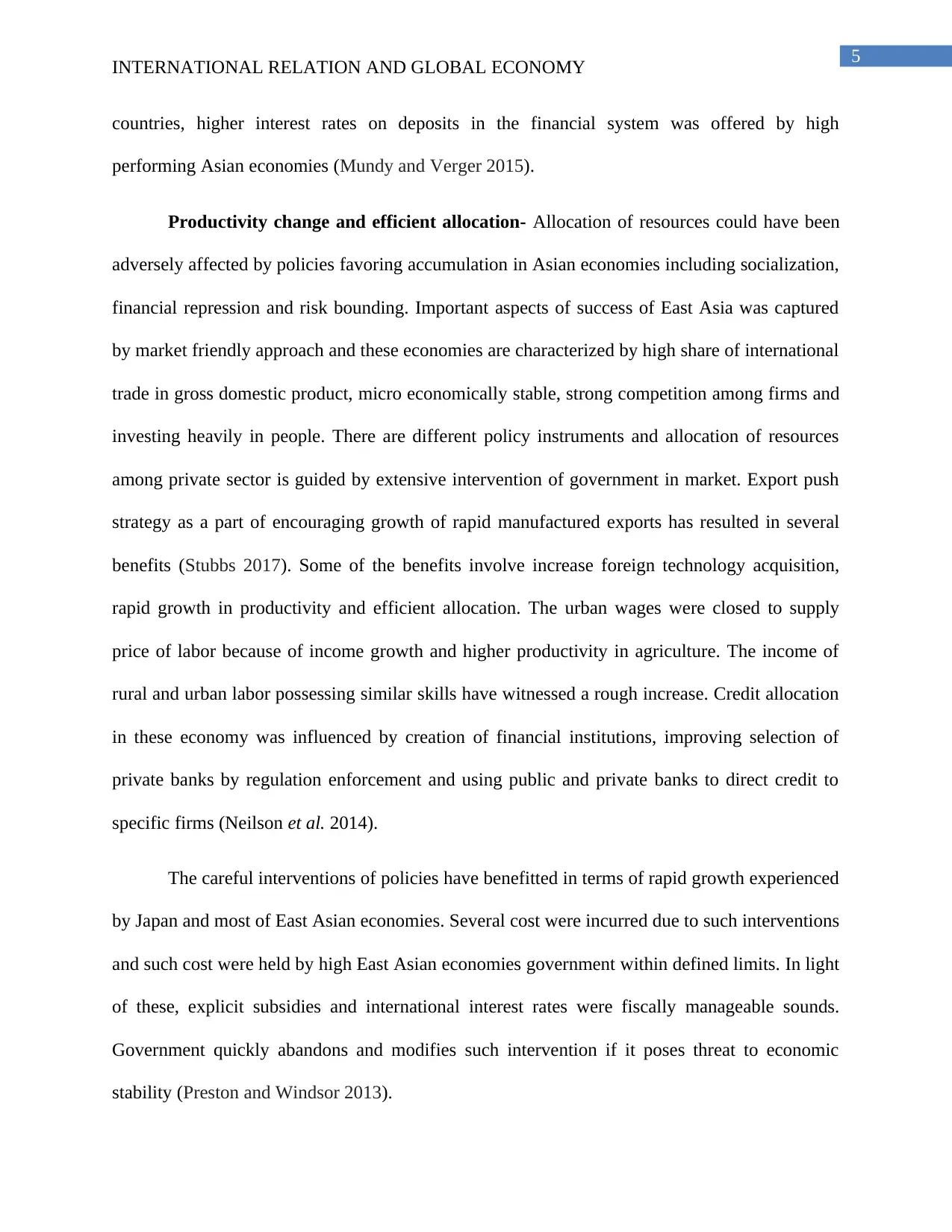
5
INTERNATIONAL RELATION AND GLOBAL ECONOMY
countries, higher interest rates on deposits in the financial system was offered by high
performing Asian economies (Mundy and Verger 2015).
Productivity change and efficient allocation- Allocation of resources could have been
adversely affected by policies favoring accumulation in Asian economies including socialization,
financial repression and risk bounding. Important aspects of success of East Asia was captured
by market friendly approach and these economies are characterized by high share of international
trade in gross domestic product, micro economically stable, strong competition among firms and
investing heavily in people. There are different policy instruments and allocation of resources
among private sector is guided by extensive intervention of government in market. Export push
strategy as a part of encouraging growth of rapid manufactured exports has resulted in several
benefits (Stubbs 2017). Some of the benefits involve increase foreign technology acquisition,
rapid growth in productivity and efficient allocation. The urban wages were closed to supply
price of labor because of income growth and higher productivity in agriculture. The income of
rural and urban labor possessing similar skills have witnessed a rough increase. Credit allocation
in these economy was influenced by creation of financial institutions, improving selection of
private banks by regulation enforcement and using public and private banks to direct credit to
specific firms (Neilson et al. 2014).
The careful interventions of policies have benefitted in terms of rapid growth experienced
by Japan and most of East Asian economies. Several cost were incurred due to such interventions
and such cost were held by high East Asian economies government within defined limits. In light
of these, explicit subsidies and international interest rates were fiscally manageable sounds.
Government quickly abandons and modifies such intervention if it poses threat to economic
stability (Preston and Windsor 2013).
INTERNATIONAL RELATION AND GLOBAL ECONOMY
countries, higher interest rates on deposits in the financial system was offered by high
performing Asian economies (Mundy and Verger 2015).
Productivity change and efficient allocation- Allocation of resources could have been
adversely affected by policies favoring accumulation in Asian economies including socialization,
financial repression and risk bounding. Important aspects of success of East Asia was captured
by market friendly approach and these economies are characterized by high share of international
trade in gross domestic product, micro economically stable, strong competition among firms and
investing heavily in people. There are different policy instruments and allocation of resources
among private sector is guided by extensive intervention of government in market. Export push
strategy as a part of encouraging growth of rapid manufactured exports has resulted in several
benefits (Stubbs 2017). Some of the benefits involve increase foreign technology acquisition,
rapid growth in productivity and efficient allocation. The urban wages were closed to supply
price of labor because of income growth and higher productivity in agriculture. The income of
rural and urban labor possessing similar skills have witnessed a rough increase. Credit allocation
in these economy was influenced by creation of financial institutions, improving selection of
private banks by regulation enforcement and using public and private banks to direct credit to
specific firms (Neilson et al. 2014).
The careful interventions of policies have benefitted in terms of rapid growth experienced
by Japan and most of East Asian economies. Several cost were incurred due to such interventions
and such cost were held by high East Asian economies government within defined limits. In light
of these, explicit subsidies and international interest rates were fiscally manageable sounds.
Government quickly abandons and modifies such intervention if it poses threat to economic
stability (Preston and Windsor 2013).
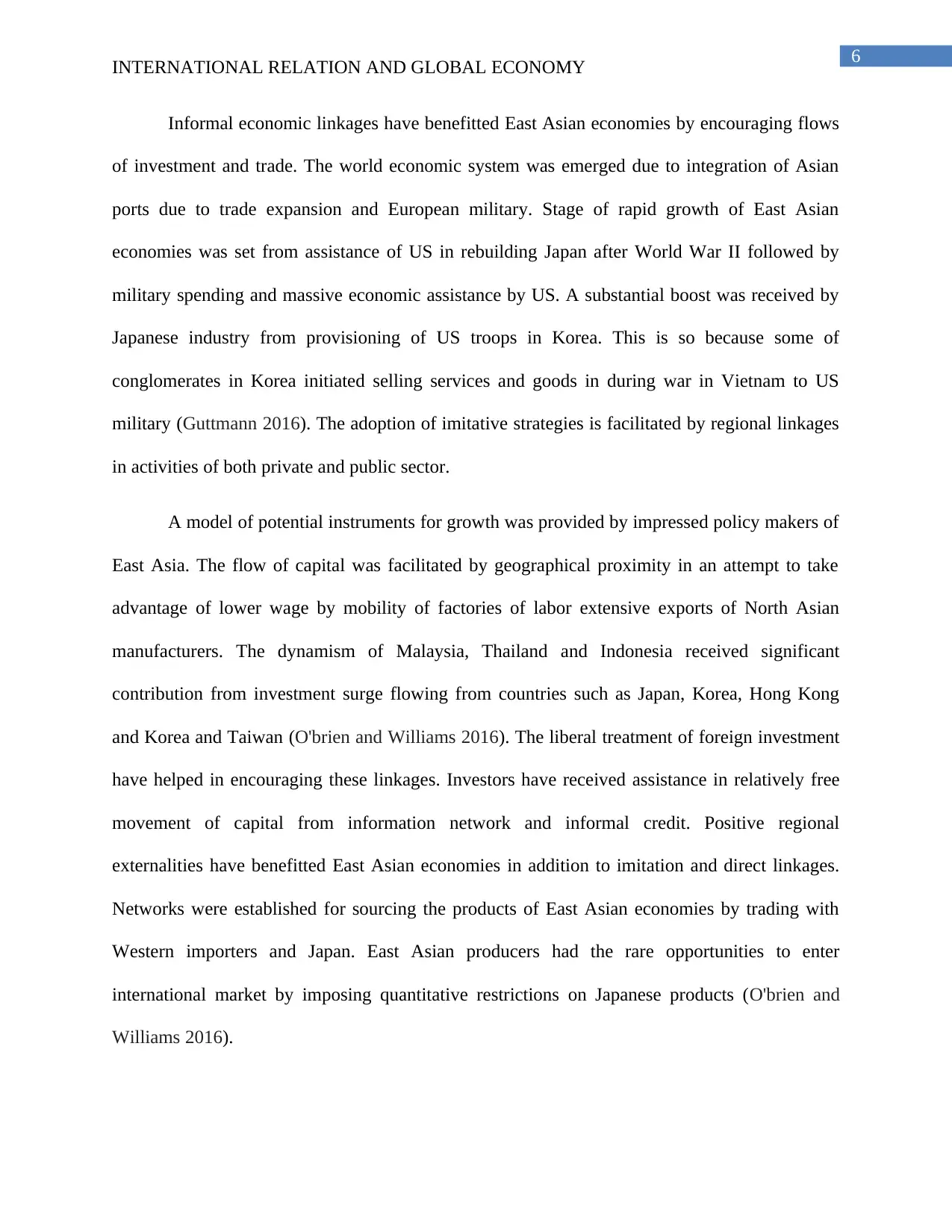
6
INTERNATIONAL RELATION AND GLOBAL ECONOMY
Informal economic linkages have benefitted East Asian economies by encouraging flows
of investment and trade. The world economic system was emerged due to integration of Asian
ports due to trade expansion and European military. Stage of rapid growth of East Asian
economies was set from assistance of US in rebuilding Japan after World War II followed by
military spending and massive economic assistance by US. A substantial boost was received by
Japanese industry from provisioning of US troops in Korea. This is so because some of
conglomerates in Korea initiated selling services and goods in during war in Vietnam to US
military (Guttmann 2016). The adoption of imitative strategies is facilitated by regional linkages
in activities of both private and public sector.
A model of potential instruments for growth was provided by impressed policy makers of
East Asia. The flow of capital was facilitated by geographical proximity in an attempt to take
advantage of lower wage by mobility of factories of labor extensive exports of North Asian
manufacturers. The dynamism of Malaysia, Thailand and Indonesia received significant
contribution from investment surge flowing from countries such as Japan, Korea, Hong Kong
and Korea and Taiwan (O'brien and Williams 2016). The liberal treatment of foreign investment
have helped in encouraging these linkages. Investors have received assistance in relatively free
movement of capital from information network and informal credit. Positive regional
externalities have benefitted East Asian economies in addition to imitation and direct linkages.
Networks were established for sourcing the products of East Asian economies by trading with
Western importers and Japan. East Asian producers had the rare opportunities to enter
international market by imposing quantitative restrictions on Japanese products (O'brien and
Williams 2016).
INTERNATIONAL RELATION AND GLOBAL ECONOMY
Informal economic linkages have benefitted East Asian economies by encouraging flows
of investment and trade. The world economic system was emerged due to integration of Asian
ports due to trade expansion and European military. Stage of rapid growth of East Asian
economies was set from assistance of US in rebuilding Japan after World War II followed by
military spending and massive economic assistance by US. A substantial boost was received by
Japanese industry from provisioning of US troops in Korea. This is so because some of
conglomerates in Korea initiated selling services and goods in during war in Vietnam to US
military (Guttmann 2016). The adoption of imitative strategies is facilitated by regional linkages
in activities of both private and public sector.
A model of potential instruments for growth was provided by impressed policy makers of
East Asia. The flow of capital was facilitated by geographical proximity in an attempt to take
advantage of lower wage by mobility of factories of labor extensive exports of North Asian
manufacturers. The dynamism of Malaysia, Thailand and Indonesia received significant
contribution from investment surge flowing from countries such as Japan, Korea, Hong Kong
and Korea and Taiwan (O'brien and Williams 2016). The liberal treatment of foreign investment
have helped in encouraging these linkages. Investors have received assistance in relatively free
movement of capital from information network and informal credit. Positive regional
externalities have benefitted East Asian economies in addition to imitation and direct linkages.
Networks were established for sourcing the products of East Asian economies by trading with
Western importers and Japan. East Asian producers had the rare opportunities to enter
international market by imposing quantitative restrictions on Japanese products (O'brien and
Williams 2016).
Paraphrase This Document
Need a fresh take? Get an instant paraphrase of this document with our AI Paraphraser
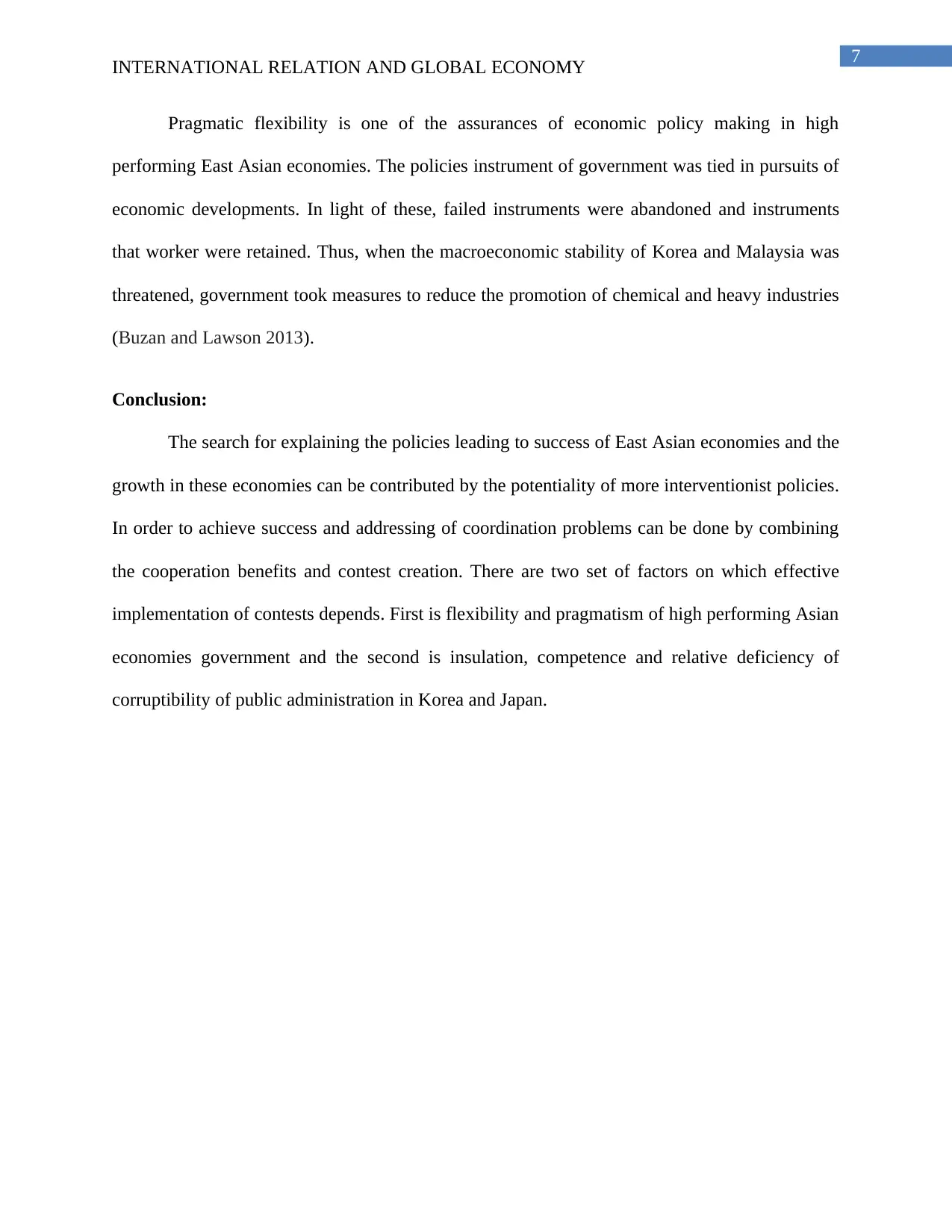
7
INTERNATIONAL RELATION AND GLOBAL ECONOMY
Pragmatic flexibility is one of the assurances of economic policy making in high
performing East Asian economies. The policies instrument of government was tied in pursuits of
economic developments. In light of these, failed instruments were abandoned and instruments
that worker were retained. Thus, when the macroeconomic stability of Korea and Malaysia was
threatened, government took measures to reduce the promotion of chemical and heavy industries
(Buzan and Lawson 2013).
Conclusion:
The search for explaining the policies leading to success of East Asian economies and the
growth in these economies can be contributed by the potentiality of more interventionist policies.
In order to achieve success and addressing of coordination problems can be done by combining
the cooperation benefits and contest creation. There are two set of factors on which effective
implementation of contests depends. First is flexibility and pragmatism of high performing Asian
economies government and the second is insulation, competence and relative deficiency of
corruptibility of public administration in Korea and Japan.
INTERNATIONAL RELATION AND GLOBAL ECONOMY
Pragmatic flexibility is one of the assurances of economic policy making in high
performing East Asian economies. The policies instrument of government was tied in pursuits of
economic developments. In light of these, failed instruments were abandoned and instruments
that worker were retained. Thus, when the macroeconomic stability of Korea and Malaysia was
threatened, government took measures to reduce the promotion of chemical and heavy industries
(Buzan and Lawson 2013).
Conclusion:
The search for explaining the policies leading to success of East Asian economies and the
growth in these economies can be contributed by the potentiality of more interventionist policies.
In order to achieve success and addressing of coordination problems can be done by combining
the cooperation benefits and contest creation. There are two set of factors on which effective
implementation of contests depends. First is flexibility and pragmatism of high performing Asian
economies government and the second is insulation, competence and relative deficiency of
corruptibility of public administration in Korea and Japan.

8
INTERNATIONAL RELATION AND GLOBAL ECONOMY
References list:
Baylis, J., Owens, P. and Smith, S. eds., 2017. The globalization of world politics: An
introduction to international relations. Oxford University Press.
Burchill, S., Linklater, A., Devetak, R., Donnelly, J., Nardin, T., Paterson, M., Reus-Smit, C. and
True, J., 2013. Theories of international relations. Palgrave Macmillan.
Buzan, B. and Lawson, G., 2013. The global transformation: The nineteenth century and the
making of modern international relations. International Studies Quarterly, 57(3), pp.620-634.
Buzan, B. and Lawson, G., 2015. The global transformation: history, modernity and the making
of international relations(Vol. 135). Cambridge University Press.
Deresky, H., 2017. International management: Managing across borders and cultures. Pearson
Education India.
Duffield, M., 2014. Global governance and the new wars: The merging of development and
security. Zed Books Ltd..
Gilpin, R., 2016. The political economy of international relations. Princeton University Press.
Guttmann, R., 2016. How Credit-money Shapes the Economy: The United States in a Global
System: The United States in a Global System. Routledge.
INTERNATIONAL RELATION AND GLOBAL ECONOMY
References list:
Baylis, J., Owens, P. and Smith, S. eds., 2017. The globalization of world politics: An
introduction to international relations. Oxford University Press.
Burchill, S., Linklater, A., Devetak, R., Donnelly, J., Nardin, T., Paterson, M., Reus-Smit, C. and
True, J., 2013. Theories of international relations. Palgrave Macmillan.
Buzan, B. and Lawson, G., 2013. The global transformation: The nineteenth century and the
making of modern international relations. International Studies Quarterly, 57(3), pp.620-634.
Buzan, B. and Lawson, G., 2015. The global transformation: history, modernity and the making
of international relations(Vol. 135). Cambridge University Press.
Deresky, H., 2017. International management: Managing across borders and cultures. Pearson
Education India.
Duffield, M., 2014. Global governance and the new wars: The merging of development and
security. Zed Books Ltd..
Gilpin, R., 2016. The political economy of international relations. Princeton University Press.
Guttmann, R., 2016. How Credit-money Shapes the Economy: The United States in a Global
System: The United States in a Global System. Routledge.
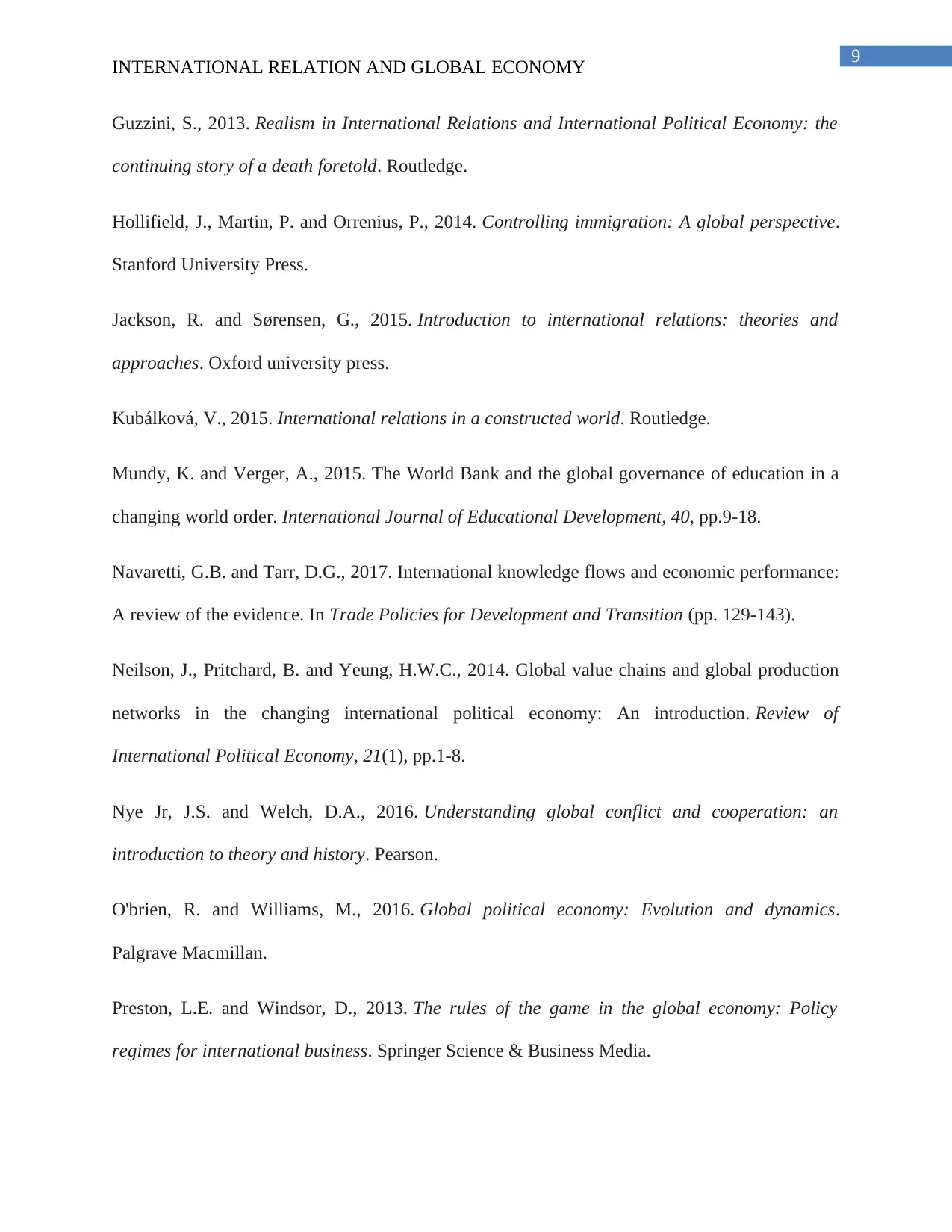
9
INTERNATIONAL RELATION AND GLOBAL ECONOMY
Guzzini, S., 2013. Realism in International Relations and International Political Economy: the
continuing story of a death foretold. Routledge.
Hollifield, J., Martin, P. and Orrenius, P., 2014. Controlling immigration: A global perspective.
Stanford University Press.
Jackson, R. and Sørensen, G., 2015. Introduction to international relations: theories and
approaches. Oxford university press.
Kubálková, V., 2015. International relations in a constructed world. Routledge.
Mundy, K. and Verger, A., 2015. The World Bank and the global governance of education in a
changing world order. International Journal of Educational Development, 40, pp.9-18.
Navaretti, G.B. and Tarr, D.G., 2017. International knowledge flows and economic performance:
A review of the evidence. In Trade Policies for Development and Transition (pp. 129-143).
Neilson, J., Pritchard, B. and Yeung, H.W.C., 2014. Global value chains and global production
networks in the changing international political economy: An introduction. Review of
International Political Economy, 21(1), pp.1-8.
Nye Jr, J.S. and Welch, D.A., 2016. Understanding global conflict and cooperation: an
introduction to theory and history. Pearson.
O'brien, R. and Williams, M., 2016. Global political economy: Evolution and dynamics.
Palgrave Macmillan.
Preston, L.E. and Windsor, D., 2013. The rules of the game in the global economy: Policy
regimes for international business. Springer Science & Business Media.
INTERNATIONAL RELATION AND GLOBAL ECONOMY
Guzzini, S., 2013. Realism in International Relations and International Political Economy: the
continuing story of a death foretold. Routledge.
Hollifield, J., Martin, P. and Orrenius, P., 2014. Controlling immigration: A global perspective.
Stanford University Press.
Jackson, R. and Sørensen, G., 2015. Introduction to international relations: theories and
approaches. Oxford university press.
Kubálková, V., 2015. International relations in a constructed world. Routledge.
Mundy, K. and Verger, A., 2015. The World Bank and the global governance of education in a
changing world order. International Journal of Educational Development, 40, pp.9-18.
Navaretti, G.B. and Tarr, D.G., 2017. International knowledge flows and economic performance:
A review of the evidence. In Trade Policies for Development and Transition (pp. 129-143).
Neilson, J., Pritchard, B. and Yeung, H.W.C., 2014. Global value chains and global production
networks in the changing international political economy: An introduction. Review of
International Political Economy, 21(1), pp.1-8.
Nye Jr, J.S. and Welch, D.A., 2016. Understanding global conflict and cooperation: an
introduction to theory and history. Pearson.
O'brien, R. and Williams, M., 2016. Global political economy: Evolution and dynamics.
Palgrave Macmillan.
Preston, L.E. and Windsor, D., 2013. The rules of the game in the global economy: Policy
regimes for international business. Springer Science & Business Media.
Secure Best Marks with AI Grader
Need help grading? Try our AI Grader for instant feedback on your assignments.
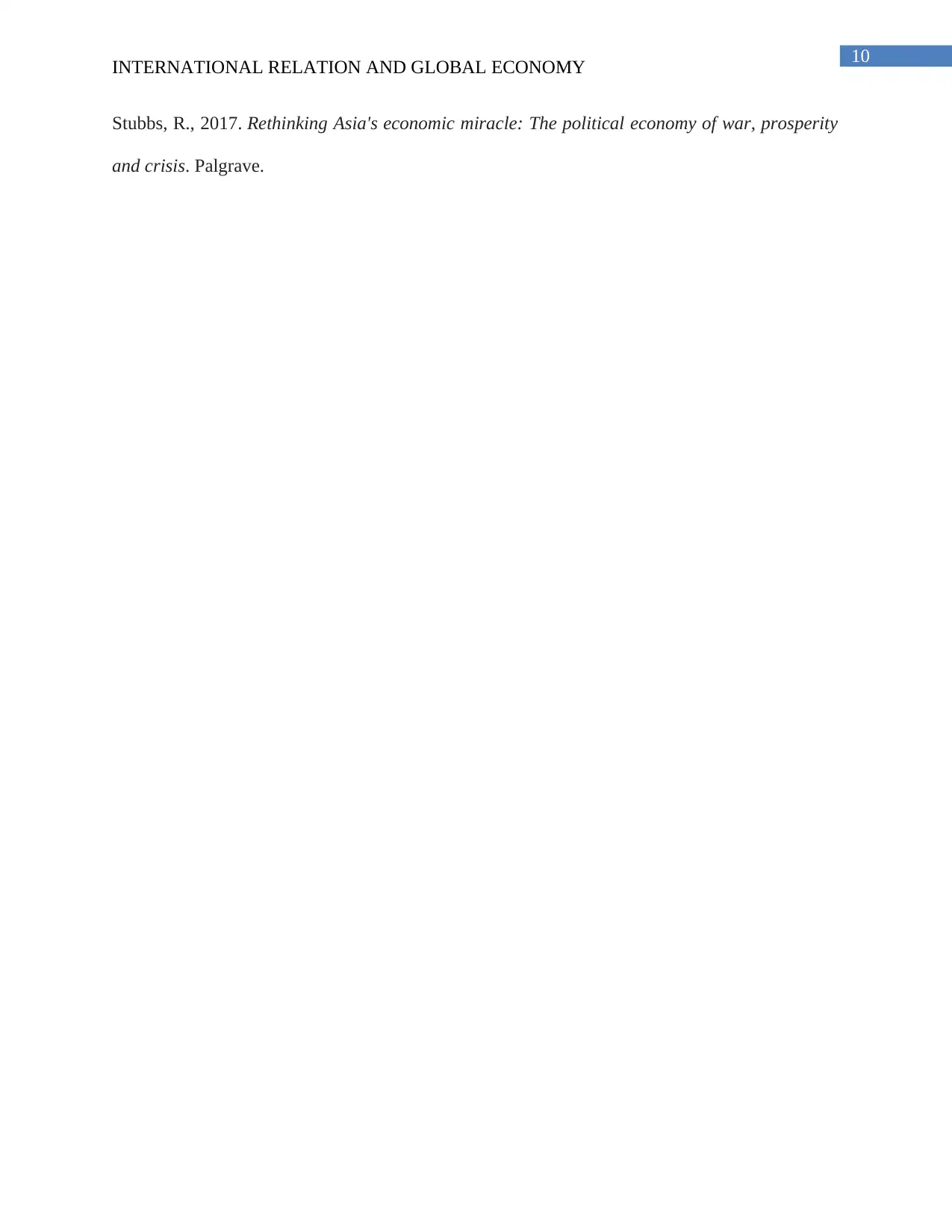
10
INTERNATIONAL RELATION AND GLOBAL ECONOMY
Stubbs, R., 2017. Rethinking Asia's economic miracle: The political economy of war, prosperity
and crisis. Palgrave.
INTERNATIONAL RELATION AND GLOBAL ECONOMY
Stubbs, R., 2017. Rethinking Asia's economic miracle: The political economy of war, prosperity
and crisis. Palgrave.
1 out of 11
Related Documents
Your All-in-One AI-Powered Toolkit for Academic Success.
+13062052269
info@desklib.com
Available 24*7 on WhatsApp / Email
![[object Object]](/_next/static/media/star-bottom.7253800d.svg)
Unlock your academic potential
© 2024 | Zucol Services PVT LTD | All rights reserved.





